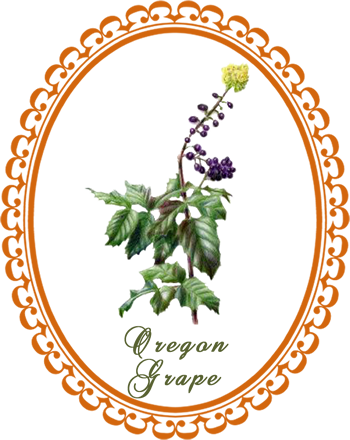
Oregon-Grape: the berry contains berberine, like goldenseal. This makes it a good substitute for the endangered goldenseal...
Common Names: Oregon Grape, Mountain Grape, Mahonia, California Barberry
Botanical Name: Berberis acquifolium, Mahonia acquifolium
Family: Berberidaceae
Plant Type: Deciduous shrub
Parts Used: Rhizome and root
Flowering: June
Oregon-grape is a native plant on the North American west coast from British Columbia to northern California, occurring in the understory of Douglas-fir forests and in brushlands. It is the state flower of Oregon. In some areas outside its native range, Oregon-grape has been classified as an invasive exotic species that may displace native vegetation.
Oregon-grape (Mahonia aquifolium, Berberidaceae) is an evergreen shrub related to the barberry. Some authors place Mahonia in the barberry genus, Berberis.
Cultivation: Oregon-grape is used in landscaping similarly to barberry, as a plant suited for low-maintenance plantings and loose hedges. It spreads easily by rhizome growth beneath the soil. Oregon-grape is resistant to summer drought, tolerates poor soils, and does not create excessive leaf litter. Its berries attract birds.
Harvesting: Collect the rhizomes and roots in the fall.
Culinary Uses: The small purplish-black fruits, which are quite tart and contain large seeds, are included in smaller quantities in the traditional diets of Pacific Northwest aboriginal peoples, mixed with Salal or another sweeter fruit. Today they are sometimes used to make jelly, alone or mixed with salal. Oregon-grape juice can be fermented to make wine, similar to European barberry wine folk traditions, although it requires an unusually high amount of sugar.
Oregon-Grape Magick
Money. Popularity.
Gender: Feminine
Planet: Earth
Carry the root to help you gain popularity.
Carry this root, or sprinkle the powder in your wallet to draw money and financial security.
Herbal Healing with Oregon-Grape
Medicinal Actions: alterative, antibacterial, anti-inflammatory, cholagogue, diuretic, laxative, stimulant (digestion), tonic
Medicinal Uses: Oregon-grape is used in Chinese medicine as a bitter herb. It is a tonic for the liver and gall bladder, waking up the digestion and improving the assimilation of food. It is used to treat abdominal distention and fullness, loose stools, diarrhea and constipation, a feeling of general heaviness, nausea, reduced appetite, reduced thirst with a dry mouth and sticky, thick mucous discharges. It also works as a sedative on the digestive tract to relieve stomach cramps and pain.
It will prevent bacteria from implanting themselves in the intestinal lining. It will boost the immune system by encouraging action by the white blood cells. Berberine protects against viruses, fungi, worms, Chlamydia and protozoans as well as the bacteria. It can increase the blood platelet count and stop the multiplication of cancerous cells in the colon and bladder.
Externally, Oregon-grape can be made into a topical cream that contains 10% herb. It can be applied to watery or oozing skin eruptions. It helps to clear up chronic, inflammatory, scaly skin conditions, noteably psoriasis and eczema. It works well with other skin tonics such as nettle (Urtica), yellow dock (Rumex crispus), and red clover (Trifolium pratense).
If you suffer from chronic diarrhea, excessive stomach acid or a duodenal ulcer, do not take this herb. Avoid during pregnancy although it is safe during nursing unless the baby suffers from jaundice. It may prevent your intestines from absorbing tetracycline or other antibiotics.
Oregon-Grape is bitter, and may cause nausea the first few doses. This normally passes after the first few tries. You should only take this herb, or any herb that contains berberine, for seven consecutive days at a time, then take a break of at least a week before taking it again. Don't take B vitamin supplements while taking Oregon-Grape, as the B vitamins may help make the infectious bacteria resistant to the herb. This herb may be used for children, but no more than three doses in a row. They then need a full day off of the herb.

Preparation and Dosage:
The herb can be used as a topical cream, as an herbal tea, a tincture or in capsules.
For Oregon-grape herbal tea, add ½ to 1 teaspoon of dried root to 2/3 cup hot water and steep for 10 to 15 minutes. This tea can be taken up to three times per day. This is not the same if you are using the chopped herb rather than the dried root.
For tincture, take 3 to 6 ml three times per day, but do not take more than three doses of any kind of the grape root preparation per day. So if you take a cup of herbal tea, only take two doses of the tincture within the same 24 hour period.
For skin problems, use 10% tincture in an ointment. Apply to the skin only three times per day.
If you appreciate the information provided,
please help keep this website running. Blessings!
© 2008-2025 aromaworx.ca. All rights reserved.

